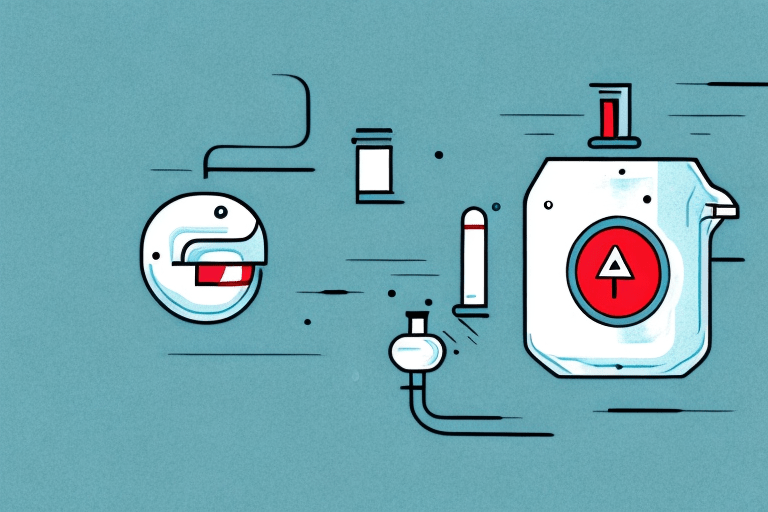In the midst of the COVID-19 pandemic, it's important to stay informed about the symptoms associated with this novel virus. One symptom that has been highlighted is chest pain, which can be quite alarming. But how can you differentiate between COVID-19 chest pain and something as common as heartburn? Let's delve into this topic further to gain a better understanding.
Understanding COVID-19 Symptoms
Before we dive into the details of COVID chest pain, let's briefly explore the more general symptoms of COVID-19. In addition to chest pain, individuals infected with this virus may experience a range of symptoms. It's important to note that each person's experience with the virus can vary. Some of the common symptoms include:
- Fever
- Cough
- Shortness of breath
- Fatigue
- Body aches
However, it's important to keep in mind that not everyone infected with COVID-19 will experience all of these symptoms, and some individuals may not display any symptoms at all. This is why it's crucial to follow the guidelines provided by health authorities, such as wearing masks, practicing social distancing, and washing hands frequently.
The symptoms mentioned above are just some of the common manifestations of COVID-19. Let's take a closer look at each one:
Fever
Fever is one of the most prevalent symptoms observed in individuals infected with COVID-19. It is characterized by an elevated body temperature above the normal range. Fever is the body's natural response to fighting off infections and can be an indication of the presence of the virus.
Cough
A persistent cough is another common symptom of COVID-19. It may start off as a dry cough and progress to a productive cough with the production of mucus. Coughing is the body's way of clearing the airways and removing irritants or infectious particles.
Shortness of Breath
Shortness of breath, also known as dyspnea, is a symptom that can range from mild to severe in COVID-19 cases. It is characterized by a feeling of breathlessness or difficulty in breathing. This symptom is often associated with lung involvement and can be a sign of more severe disease.
While the more common symptoms we mentioned are widely observed, COVID-19 has also been known to cause a range of less common symptoms, some of which include:
- Loss of taste or smell
- Sore throat
- Nausea
- Vomiting
- Diarrhea
These less common symptoms may be present alongside the more common symptoms or may manifest on their own. Loss of taste or smell, also known as anosmia, has been reported as a distinct symptom of COVID-19. It can affect the ability to perceive flavors or detect odors, leading to a diminished sense of taste and smell.
Sore throat, nausea, vomiting, and diarrhea are symptoms that can be associated with gastrointestinal involvement in COVID-19. While respiratory symptoms are more commonly observed, these gastrointestinal symptoms can occur and should not be ignored.
If you experience any of these symptoms, it's important to stay vigilant and seek medical advice when necessary. Remember, early detection and prompt medical attention can help in managing the impact of COVID-19 and preventing its spread.
Exploring Chest Pain in COVID-19
Now that we've covered the general symptoms, let's focus on chest pain specific to COVID-19. Chest pain can be a cause for concern, as it can sometimes indicate a more serious underlying condition. In the context of COVID-19, chest pain can be a symptom experienced by some patients. It's essential to understand the possible causes and how it differs from heartburn.
When it comes to COVID-19, there are various reasons why chest pain may occur. One possible cause is inflammation of the lungs, known as pneumonia, which can result from the viral infection. Pneumonia causes the air sacs in the lungs to fill with fluid or pus, leading to chest pain and difficulty breathing. Another potential cause is the strain on the heart due to the virus's impact on the cardiovascular system. COVID-19 can cause inflammation of the heart muscle, known as myocarditis, which can lead to chest pain and other symptoms.
It's important to mention that chest pain may not always be directly related to COVID-19 itself; it can also be a result of anxiety or stress caused by the pandemic. The uncertainty and fear surrounding the virus can lead to heightened stress levels, which can manifest as chest pain. Additionally, the lifestyle changes brought about by the pandemic, such as reduced physical activity and increased sedentary behavior, can contribute to chest pain unrelated to COVID-19.
In any case, if you experience chest pain, it's crucial to consult with a healthcare professional to determine the underlying cause. They will be able to evaluate your symptoms, perform necessary tests, and provide appropriate treatment or guidance.
How COVID-19 Chest Pain Feels
COVID-19 chest pain can vary in intensity and sensation from person to person. Some individuals describe it as a sharp or stabbing pain, while others experience a dull or aching sensation. The pain may be localized in the chest or spread to other areas, such as the back or shoulders.
In addition to the physical sensations, COVID-19 chest pain can also be accompanied by other symptoms. These may include shortness of breath, coughing, fatigue, and fever. However, it's important to note that COVID-19 chest pain can occur without any other respiratory symptoms. This is why it's vital to pay close attention to your body and seek medical advice if you experience any unusual symptoms, particularly if you suspect COVID-19 infection.
Furthermore, it's worth mentioning that chest pain can have various causes other than COVID-19. Common non-COVID-19 related causes of chest pain include heartburn, muscle strain, anxiety, and gastrointestinal issues. Heartburn, also known as acid reflux, occurs when stomach acid flows back into the esophagus, causing a burning sensation in the chest. Muscle strain, often caused by physical exertion or injury, can lead to chest pain that worsens with movement. Anxiety and panic attacks can also cause chest pain, as the body's stress response can trigger muscle tension and chest tightness. Gastrointestinal issues, such as gallstones or peptic ulcers, can also cause chest pain that may be mistaken for a COVID-19 symptom.
In conclusion, chest pain can be a symptom of COVID-19, but it can also have other causes. It's important to consider the context of your symptoms, such as exposure to the virus or presence of other respiratory symptoms, and consult with a healthcare professional for an accurate diagnosis. They will be able to evaluate your symptoms, perform necessary tests, and provide appropriate guidance or treatment.
Comparing COVID-19 Chest Pain and Heartburn
Now that we have a better understanding of COVID-19 chest pain, let's compare it to heartburn. Although they can present with similar symptoms, there are some key differences between the two.
What is Heartburn?
Heartburn is a condition caused by the reflux of stomach acid into the esophagus. The acidity and discomfort associated with heartburn are often felt in the chest area, just behind the breastbone. It can give rise to a burning sensation and may be accompanied by a sour or acidic taste in the mouth.
Symptoms of Heartburn
In addition to the burning sensation in the chest, heartburn can also cause:
- Regurgitation of food or liquid
- Difficulty swallowing
- Hoarseness or a sore throat
If you experience heartburn symptoms, they are typically relieved by antacids or lifestyle changes, such as avoiding trigger foods and maintaining a healthy weight.
Similarities and Differences Between COVID-19 Chest Pain and Heartburn
Both COVID-19 chest pain and heartburn can present with a pain or discomfort in the chest area. However, there are a few key differences in their symptoms:
- COVID-19 chest pain is often accompanied by other COVID-19 symptoms, while heartburn symptoms may not be linked to any other specific illness.
- COVID-19 chest pain can occur even in the absence of respiratory symptoms, while heartburn symptoms are usually isolated.
- Relief methods differ: COVID-19 chest pain requires medical attention, while heartburn symptoms can often be alleviated by over-the-counter remedies or lifestyle changes.
Considering these differences, if you are unsure about the cause of your chest pain, it's always best to consult with a healthcare professional to rule out any serious underlying conditions.
When to Seek Medical Attention
Knowing when to seek medical attention can be crucial in identifying and addressing potential health concerns. Here, we'll explore the warning signs associated with COVID-19 and when heartburn might be something more serious.
Warning Signs in COVID-19
While chest pain is one symptom that might prompt you to seek medical attention, it's essential to be aware of other signs that could indicate a severe case of COVID-19. These signs include:
- Difficulty breathing or severe shortness of breath
- Persistent chest pain or pressure
- Confusion or difficulty waking
- Bluish lips or face
- Sudden inability to stay awake
If you experience any of these warning signs, it's crucial to seek immediate medical care.
When Heartburn Might Be Something More Serious
Although heartburn is typically a benign condition, there are instances when it might indicate a more serious issue. Seek medical attention if you experience any of the following:
- Chest pain that radiates to the neck, jaw, or left arm
- Shortness of breath or difficulty swallowing
- Unexplained weight loss or loss of appetite
These symptoms might suggest a more severe condition such as a heart attack or other cardiac issues. It's always better to err on the side of caution and consult with a healthcare professional when in doubt.
Prevention and Treatment
Now that we have a better understanding of COVID chest pain and heartburn, let's explore prevention and treatment options for both conditions.
Preventing COVID-19 and Heartburn
Preventing the spread of COVID-19 involves following the guidelines provided by health authorities. This includes practicing good hand hygiene, wearing masks in public, and maintaining social distancing. To reduce the risk of heartburn, it can be helpful to avoid trigger foods (such as spicy or fatty foods), maintain a healthy weight, and eat smaller, more frequent meals.
Treatment Options for COVID-19 and Heartburn
When it comes to treating COVID-19, medical professionals will provide guidance based on your specific case and symptoms. Treatment options for heartburn typically involve lifestyle modifications, such as dietary changes, weight management, and over-the-counter antacids or acid reducers. In severe cases, prescription medications may be recommended.
It's important to note that self-diagnosis and self-medication are never ideal approaches. Always consult with a healthcare professional for an accurate diagnosis and appropriate treatment options.
In conclusion, while COVID-19 chest pain and heartburn can share similarities in terms of chest discomfort, they have distinct characteristics. Understanding the symptoms, seeking medical attention when necessary, and following preventive measures are all vital in maintaining your well-being. Remember, your health is a priority, and staying informed is a significant step in safeguarding it.








